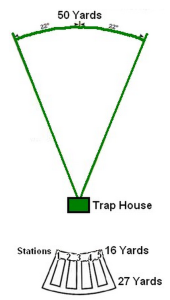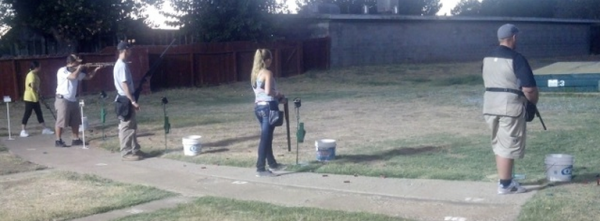Trap shooting, often called “American trap shooting” to distinguish it from other forms of trap shooting, is but one of many sports based on shooting small disks launched into the air. These disks are of various sizes. They are shaped somewhat like a Frisbee and fly in a nice arc through the air. They are made of various combinations of substances so that they break when hit. Well, sometimes they don’t break, but they’re supposed to break. The matter of “hard” clay pigeons is a constant source of complaint. Clay pigeons are commonly called “birds”. In addition to trap shooting, people also shoot other games involving these disks, such as skeet, sporting clays, 5 stand and wobble trap. This last is like trap shooting, except the trap machine is set up to very both the direction of the clay pigeon’s flight and the angle of elevation.
 Trap is shot at the MSI trap range. A trap range has at least one, and perhaps many, trap fields, each of which has a little structure called the “trap house” that houses the machine that throws the birds into the air. This is called the “trap machine,” and sometimes just the “trap.” The trap machine throws the birds in a random pattern limited to a 44 degree horizontal arc, with the birds exiting the house at about 47 miles per hour and traveling about 50 yards before hitting the ground. The trap range uses either a hand release run by the score keeper, or voice calls that respond to the shooters’ voices to send an electric signal that causes the trap machine to launch a bird. Each trap field has five shooting stations in an arc, each station being 11 degrees away from its neighbor. The shooting stations are paths radiating out from the trap house with distances from the house marked from 16 to 27 yards. A round of trap is 25 birds, 5 birds being shot from each station in rotation.
Trap is shot at the MSI trap range. A trap range has at least one, and perhaps many, trap fields, each of which has a little structure called the “trap house” that houses the machine that throws the birds into the air. This is called the “trap machine,” and sometimes just the “trap.” The trap machine throws the birds in a random pattern limited to a 44 degree horizontal arc, with the birds exiting the house at about 47 miles per hour and traveling about 50 yards before hitting the ground. The trap range uses either a hand release run by the score keeper, or voice calls that respond to the shooters’ voices to send an electric signal that causes the trap machine to launch a bird. Each trap field has five shooting stations in an arc, each station being 11 degrees away from its neighbor. The shooting stations are paths radiating out from the trap house with distances from the house marked from 16 to 27 yards. A round of trap is 25 birds, 5 birds being shot from each station in rotation.
Trap shooters commonly shoot three events: singles, handicap and doubles. Singles are single birds shot from the closest distance, 16 yards from the trap house. Since the birds are usually about 15 to 25 yards out by the time the shooter fires, even the 16 yard singles are 31 to 41 yards away. Handicap is like singles, except it is shot from various distances, depending on one’s ability, between 19 and 27 yards. These birds are 35 to 52 yards away, depending on one’s handicap and reaction time. Since very few shooters with slow reaction times ever earn a 27 yard handicap, that 52 yard figure is an exaggeration. 27 yard shooters actually shoot their birds at 47 yards or less. As you might imagine, a little disk, 40+ yards away and flying at 40+ miles per hour can be a difficult target. Doubles are two birds launched simultaneously, shot from 16 yards. Doubles are even more difficult and are, by far, the most fun. A round of doubles at MSI is 15 pairs, or 30 birds.
You can use any shotgun gauge, up to 12 gauge. Using anything smaller than a 12 gauge entails a loss of hitting power. Some do choose smaller guns for their lower weight and reduced recoil. Note: in shotguns, a larger numerical gauge designation refers to a smaller bore. A 20 gauge is smaller than a 12 gauge. This holds true for all shotgun bore sizes other than the .410. “.410” refers to a bore that is .410 of an inch in diameter. Unless you are truly crazy, you will not be using a .410 to shoot trap. It is just too small. You may use up to 1 1/8 ounce of shot in 12 gauge. You may use shot sized 7 1/2 and smaller. Like gauge sizes, a lower shot size number refers to a larger shot size. The maximum velocity allowed is 1250 feet per second for 1 1/8 ounce loads. You may use slightly higher velocities for lighter loads, and the whole thing gets really complicated. Why bother with all that? Just get some 1 1/8 ounce #8 shot target loads.
If you want to try trap shooting MSI, and, you really should. Come out Saturdays between 10 and 4, gather up the necessary equipment, and go. You will probably feel intimidated by the prospect of trying this sport, but if you’ll just go and give it a try, you’ll find that you will be welcomed by the participants. Practicing safe gun handling is the primary concern. Even though trap shooting is a game, there is absolutely no room for unsafe gun handling.
You’ll need a shotgun, ammunition, hearing protection, eye protection and some money. Trap ranges fee for a round of trap can be found on the MSI home page. Glasses, including sunglasses, will suffice for eye protection. Hearing protection consists of either ear muffs or those little foam thingies you stick in your ears. I could never get used to those, so I use ear muffs. Some trap shooters get high-tech ear muffs with electronic circuits that allow normal hearing while blocking loud noises. As explained above, ammunition is limited to 1 1/8 ounce of shot. Wal*Mart sells 100 round value packs of target ammunition made by Remington, Federal and Winchester. These are excellent choices for beginning shooters. Many experienced shooters also use them.
Just about any shotgun with a full or modified choke will do. If you can handle a 12 gauge, that will work better than a smaller gun. Trap shooters often use specially configured trap guns. One of the best shooters at my local club shoots a regular field gun. If you really get “into” trap shooting, you will learn the characteristics of trap guns and field guns, and you will be better able to decide whether you want to put money into a trap gun. You don’t need a trap gun to try trap shooting. On the other hand, you will find that having a shell holder belt will be useful. This is a belt with a container for holding shotgun shells.
Trap shooting has some simple, straightforward rules. Always practice safe gun handling. Only load your gun when it’s your turn to shoot. Only load one shell unless you’re shooting doubles. For doubles, you may load two. If, while you’re on the trap field, the staff needs to tend to the trap house, to reload the machine or otherwise adjust the machine, unload your gun. In trap shooting, the gun’s safety is ignored. Do not bother with it. Your gun is either loaded and ready to shoot, or unloaded. The only “safety” is an unloaded gun.
There are several interesting rules about gun failures, broken birds and so on. Your fellow shooters and/or the score keeper will help you with them. Just don’t get flustered. While shooting doubles, remember that you are only allowed one shot at each bird. If you miss your first bird, you must switch to the second bird and try to break it instead of shooting at the first bird again. Even though a round consists of 25 birds, and a round of doubles consists of 30 birds, you should carry some spare shells in addition to the 25 or 30 you expect to shoot. If a bird is broken in the process of being thrown, you’ll get another bird to shoot. If you shoot at that broken bird, you’ll need a spare shell. If you shoot out of turn, you’ll need to reshoot that turn. If, in doubles, you shoot the first bird without noticing that your second bird broke while being thrown, you’ll have to reshoot that turn. If your gun fails to fire after you hit your first bird in doubles, you’ll have to reshoot that turn. Obviously, if you miss your first bird, a failure to fire on your second bird counts as a lost pair. Otherwise, sly shooters would tend to have a lot of “fail to fire” episodes after lost first birds.
“Lost birds” are birds you didn’t break. “Dead birds” are the ones you did break. A dead bird means you definitely broke the bird. Knocking a little dust off it isn’t enough. You must at least knock a chip out of the bird. Ordinarily, the score keeper announces the lost birds but not the dead birds. Among trap shooters, dead birds are the norm, and therefore not worthy of mention. On the other hand, lost birds are announced with great gusto. Hearing “lost” over and over again can get to be quite annoying, to say the very least. In doubles, the score keeper announces the results of every shot: “dead pair,” dead, lost,” “lost, dead,” or “lost pair.” “Lost pair” is never a pleasant sound.
Trap shooters welcome all “newbies” except the ones who don’t practice gun safety. Parents or other responsible parties should accompany children. MSI usually has ammunition for sale.
